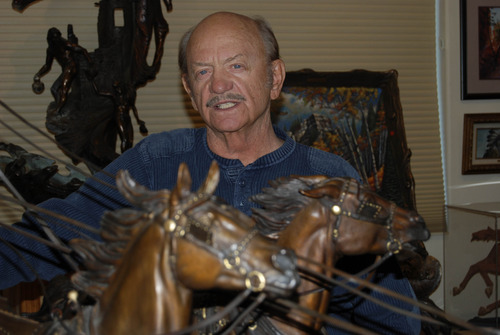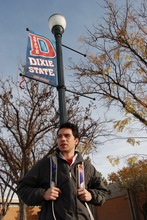This is an archived article that was published on sltrib.com in 2012, and information in the article may be outdated. It is provided only for personal research purposes and may not be reprinted.
St. George • Amid a contentious debate about whether to keep the "Dixie" in Dixie State College's name, campus officials on Thursday removed a prominent statue of Confederate soldiers that has become a flash point.
"The Rebels," by Utah sculptor Jerry Anderson, depicts a mounted soldier holding the South's famous Civil War battle standard and helping an injured comrade. For the past 25 years, the life-size bronze statue has stood in front of the Avenna Center, where it is now fueling the argument that the college's name ties it to the racist traditions of the slave-holding South.
As a staging area for recent anti-racism rallies, it has become vulnerable, and putting it in storage is the best way to protect it for now, according to Dixie State President Stephen Nadauld.
"The statue has become a lighting rod. We feel bad about that," Nadauld said. "It's a beautiful piece of art. We are nervous something might happen to the statue. It might be vandalized."
But Anderson, who has produced numerous statues on display outdoors at Dixie and Southern Utah University, was disappointed.
"It looks like they have succumbed to the adversary," Anderson said. "They are a bunch of wusses. That's the first action taken to get rid of it. The other people are winning. That's the way it is in the world. We are giving in to people who really aren't Americans."
The rallies have been organized by critics who say the Dixie name should be retired. Last week, someone threw a sheet over the statue's Confederate flag.
The statue's removal is the latest development in a campus discussion that is becoming increasingly confrontational, including a warning from Dixie's leading benefactor that donors will cut off support if Dixie is dropped.
Legislation is in the works to elevate Dixie to university status as early as next year, prompting the need to come up with a new name.
A growing chorus — which includes student body president Brody Mikesell, a senior from Henefer, and former trustee chairman Shan Gubler — is lobbying to drop or downplay the Dixie name, arguing that its associations with the Confederacy will alienate the larger audience the college aspires to reach as a university.
"It is a wonderful privilege to have a university in our community. It brings with it increased responsibility. It lifts us upon the world's stage and the world becomes our audience," said Gubler, a 1981 graduate now serving Dixie as professor of business.
"We have no intention to be racially biased," Gubler added. "This was never intended to be hurtful, but the world doesn't see it that way, and we have invited the world here."
On Tuesday, administrators summoned Mikesell to a meeting and cautioned him to make it clear he is not speaking for the student body when he advocates for a name change.
Dixie has been the school's name for a century, arising from the moniker southwest Utah earned in the 19th century when Mormon pioneers, including families from the South, sowed the Virgin River basin with cotton.
Ralph Atkin, the founder of SkyWest Airlines and Dixie's top donor, said the college risks losing philanthropic support.
"The history, the traditions, the loyalties wrapped into one are critical things to keep the community tied to the school," Atkin said. "If you take Dixie out of the name you are taking the community out of the school," said Atkin, a 1965 graduate who co-chairs the school's capital campaign committee. "They will not be bringing their money here."
Anderson contends his sculpture was not meant to glorify the Confederate cause, but celebrate brotherhood. It was inspired by the Edward Madden poem "Two Little Boys," which tells the story of two brothers fighting for the Union in the Civil War.
"The meaning is helping each other," Anderson said. "What more can you do than reach down to help a brother in need in war?"
He portrayed the soldiers as Confederates because the patrons who paid for the sculpture in the mid-1980s wanted to connect it with the Dixie Rebels, then the name of the school's sports team and an integral part of the campus identity.
The college changed its team name to the Red Storm in 2009; officials said they wanted to shed that Confederate association.
Meanwhile, campus officials are researching city records to determine who actually owns the monument. It was commissioned by a group of St. George residents and donated to the city for display at what was then called the Dixie Center. When the city built a new convention center, the state bought the land and took over the facility.
But it's unclear whether Anderson's statue came with the deal, according to Dixie marketing director Steve Johnson.
"If we owned the statue, it is due to eminent domain," Johnson said. "The college doesn't want to be monetarily responsible if it is damaged. We don't want to take a chance. It's a great piece of art by one of Utah's own."





